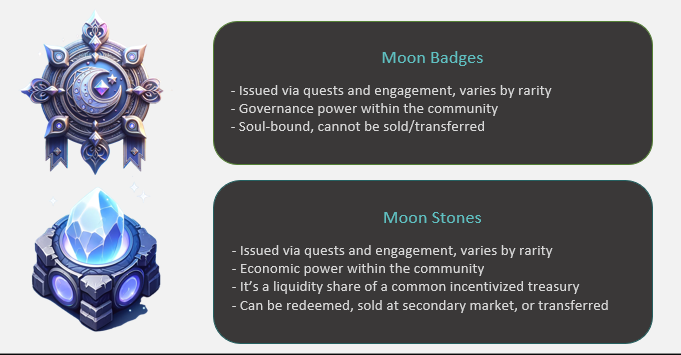Notes on the Ongoing Moonvilla Experiment
Notes on the Ongoing Moonvilla Experiment
Hey folks, this is my first post here. Very happy to be a part of the forums!
I’ve been working on socio-economic research and experimentation with novel protocols on governance and tokenized incentives for almost two years and would like to share some notes on Moonvilla, which is a Moonbeam community that is based on this research.
First of all, a little about myself. My name is Rafael Castaneda, but I’m known as “Casta Crypto” or just “Casta” which is the name of my YT Channel. My background is in software engineering with a M.Sc. from the Military Institute of Engineering in Brazil (IME/RJ), and +20 years in development and as an academic professor/researcher.
In 2021 I boarded the crypto train, and now I work full time with it as a blockchain researcher/builder, community founder, consultant, and also as a content creator on my channel “Casta Crypto”, where I foster a more philosophical, sociological, and economic approach to crypto.
In 2023, I published the Valocracy Manifesto (https://valocracy.xyz) which is a novel proposal for on-chain human coordination that attempts to bridge the current gaps that prevent DAO’s from working as well as we wish they would, while also creating new incentives that better address the separation of economic and governance dimensions of digital communities.
In March 2024, we presented our MVP implementation for a Valocracy community at the ETH Samba Hackathon in Brazil, where we secured the first place. Afterwards, we got a grant from Moonbeam to develop a community in Brazil based on the ideals and principles of Valocracy.
That’s how we got to MoonVilla (https://moon.villas/), an engage-2-earn community that has been constructed over the last months.
In MoonVilla users engage in quests on the Moonbeam Ecosystem and receive valocratic rewards for their actions.
On the engagement side, it performs similarly to the current approach in systems such as Layer 3, Intract, and Galxe, which involve recurring social or on-chain tasks.
Where our approach diverges is in regards to rewarding, where unlike the current airdrop scenario, where engagement usually delivers points or hopes for the future, a Valocracy brings real-time community-oriented returns.
If we would cover all the principles behind a Valocracy this post would be too dense, but the most important thing to highlight is that in a Valocracy we use a new tokenomics in order to better split economy and governance concerns by using a dual-NFT system.
For each performed quest, a user gets “Badges” and “Stones”:

By employing this valocratic approach, we can foster new dynamics:
1) Fair distribution: It doesn’t matter if you missed any particular campaign, particular step, or any crazy requirements. If you engage, you get a stone/badge, and it entitles you to economic and governance power proportionally to your engagement.
2) Governance-attack resistance: As governance power is issued while the community engages and it is represented as a soul-bound asset, it becomes really harder to attack the governance when compared to a traditional DAO where you just buy the token and get massive voting rights.
3) Incentivized Recurrence: As time passes and people engage, new stones and badges are continually minted. So, people that abandon the community are naturally diluted over time, and recurrent engagement is rewarded.
4) Incentivized Efficiency: Stones/badges are inflationary, not capped. But they are NFTs that represent something and not ERC-20 tokens to be speculated. So, what happens is that governance is always capped at 100%, and the inflation of badges merely redistributes governance power between the parts, all while the common treasury behaves as an economic cap, and the minting of more stones merely redistributes the ownership of the treasury. Overall, a Valocracy must strive to bring revenue to its treasury at a greater rate than it issues stones/badges, this is what makes a valocratic arrangement efficient; it must accrually reward engagement that fosters treasury growth.
4) Becoming a Valueholder: To be in the possession of Valocratic Stones is to be entitled to a share of a common treasury. At any time the stones may be burned, and the shares can be redeemed. But if the valocratic community is efficient, then the treasury grows at higher pace than the issuance of new stones. As such, people may want to hold the stones in order to redeem in the future, or even sell some stones (that goes with the Badge, which is soul-bound) at a premium on the secondary market, for someone who wants to be invested in the treasury but does not want to engage in the community.
Right now, in Moonbeam, we rely on several Remark (RMRK) standards that are able to deal with this complexity, such as ERC-6220 (composable NFTs) and ERC-7590 (ERC-20 Holder).
We are just starting, with a small pool of rewards, just to check the dynamics and test both our contracts and the application itself. Nevertheless, we are already operational with 1000 members in BR, with two ongoing campaigns and already minting badges and stones.
So, if you have a project on Moonbeam that you would like to be featured on the MoonVilla and to be engaged by this community, or if you are interested in knowing more about the project, please feel free to contact me!
Cheers!